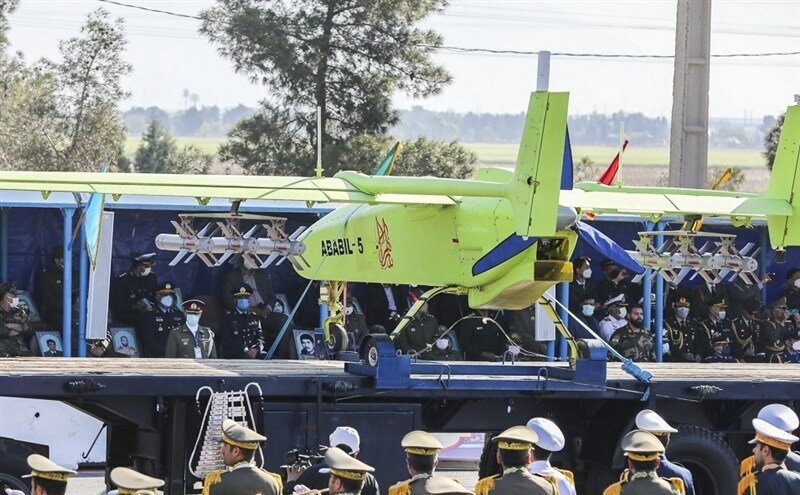Ababil 5: Novel step forward in evolution of Ababil UAVs

TEHRAN- Iran's progress in designing and manufacturing UAVs has always been magnificent over the last three decades, and Iran-made UAVs have demonstrated their high value in surveillance and spotting, targeting, and offensive operations in battlefields, particularly in the last decade due to the occurrence of regional conflicts.
Iran is presently one of the top ten UAV powers in the world, and one of the few countries with a progressive trend in UAV design, development, and manufacturing.
The Ababil UAV family, of which numerous versions have been constructed so far, notably the Ababil 3, has emerged successfully in various operational scenes. It is one of the successful UAVs made in Iran with a magnificent operational history. In 2014, the Ababil 3 drone was revealed and handed over to the Iranian Armed Forces.
The large and diversified presence of drones belonging to elements of the Army of the Islamic Republic of Iran was one of the major and distinguishing characteristics of the parade on April 18, 2022, in Tehran. Experts and domestic and international media were drawn to the name Ababil 5, which had previously been unknown.
The drone, which was initially observed, is an overview of a reconnaissance and attack drone that, when compared to several well-known Iranian drones, represents a succession of significant and successful enhancements.
With all of its successes and excellent operational experiences, the Ababil UAV family is not limited to the first, second, or third generations, and with the display of the Ababil UAV 5 during the current Iranian year's Army Day parade, it became clear that the process of upgrading the Ababil UAV family continues. The Ababil 5 drone is a cross between the Mohajer 6 and the Ababil 3 drones.
Three Ababil 5 drones were showcased on mobile tractors during the parade on April 18, 2022. Two diamond rocket launchers were seen under one wing of one of the drones, while three guided and double-barreled Qaem–class bombs were seen under each wing of another drone.
Some analysts believe the Ababil 5 drone is a smaller version of the Mohajer 6 drone, which can carry six smart bombs from the Qaem-class series.
The Ababil 5 UAV has a range of about 480 kilometers and is armed with a Qaem bomb and four Diamond-2 air-to-air missiles with a range of roughly 8 kilometers.
When looking at the body shape of the Ababil 5 drone, it is clear that the rear part of the fuselage, particularly the tail, has the same famous H-shaped design that was used in the early models of the Ababil 3 as well as the upgraded Atlas design, but the front and possibly the nose has a more advanced design than the Mohajer 6 drone.
The drone's wing span has also grown, as has the volume of portable ammo carried by the drone. Although the technical details of this UAV have not been released, Ababil 5 is expected to employ a Rotax 914 engine with 115 horsepower and specifications similar to Mohajer 6.
The Ababil 5 military reconnaissance drone, which is designed and sized similarly to the well-known Mohajer 6, is armed with four diamond air-to-surface anti-tank missiles with an 8-kilometer range and the capacity to "shoot and forget" under each wing and intelligently follows the course.
Another interesting feature of the UAV is that, according to accessible photographs, the front landing gear can be folded within the fuselage. This clearly demonstrates that new concepts were employed in the design of the Ababil 5's front end, and we are confronting more space while withdrawing the gear set from under the drone during flight, allowing for increased speed and improved aerodynamic circumstances.
Although the Ababil 5 UAV's specs and coordinates have not been officially released, based on its larger appearance and ability to carry more ammo, the Ababil 5 is likely to rank better than the Mohajer 6 in terms of durability, flying altitude, and portable cargo.
In reality, the development of UAVs like the Mohajer 6 and Ababil 5 series reveals the adoption and continuance of a successful and beneficial defense policy in the field of increasing UAV capabilities and delegating a substantial portion of armed forces operations to these birds.
This is based on knowledge obtained by the existence and use of military surveillance drones in 21st-century conflicts like the Karabakh war in 2020 and the Ukraine war in 2022.
At the same time, our country's wide terrain, particularly in the east and along the frontiers, has increased the necessity for drones for border surveillance and prospective operations against criminals, drug traffickers, and terrorist groups.
The Islamic Republic Army's tremendous development in drone capacity in recent years implies serious preparation to cover this kind of territory with drones.
The Ababil 5 drone allows an unmanned aerial vehicle to conduct surveillance operations over a broad region for a low cost in a short amount of time, while arming the drone with a choice of Qaem bombs or diamond missiles provides it tremendous strike and attack capacity to undertake combat tasks.
